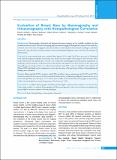Please use this identifier to cite or link to this item:
https://hdl.handle.net/20.500.14356/1142Full metadata record
| DC Field | Value | Language |
|---|---|---|
| dc.contributor.author | Devkota, Ramila | - |
| dc.contributor.author | Bhattarai, Mamata | - |
| dc.contributor.author | Adhikari, Bikash Bikram | - |
| dc.contributor.author | Devkota, Rameshwor | - |
| dc.contributor.author | Bashyal, Saroja | - |
| dc.contributor.author | Regmi, Pradeep Raj | - |
| dc.contributor.author | Amatya, Isha | - |
| dc.date.accessioned | 2023-04-27T09:13:03Z | - |
| dc.date.available | 2023-04-27T09:13:03Z | - |
| dc.date.issued | 2021 | - |
| dc.identifier.citation | DevkotaR., BhattaraiM., AdhikariB. B., DevkotaR., BashyalS., RegmiP. R., & AmatyaI. (2021). Evaluation of Breast Mass by Mammography and Ultrasonography with Histopathological Correlation . Journal of Nepal Health Research Council, 19(03), 487-493. https://doi.org/10.33314/jnhrc.v19i3.3476 | en_US |
| dc.identifier.issn | Print ISSN: 1727-5482; Online ISSN: 1999-6217 | - |
| dc.identifier.uri | http://103.69.126.140:8080/handle/20.500.14356/1142 | - |
| dc.description | Original Article | en_US |
| dc.description.abstract | Abstract Background: Mammography, ultrasound and Magnetic Resonance Imaging are the available modalities for the evaluation of breast masses. Advances and ongoing improvements in imaging technologies have improved the sensitivity of breast cancer detection and diagnosis, but each modality is most beneficial when utilized according to individual traits such as age, risk factors, and breast density. However, pathological diagnosis is most crucial for the treatment of breast masses. Methods: A cross-sectional study were conducted from January 2017 to April 2018. There were total of 50 patients with clinically diagnosed palpable breast lumps who attended Gynaecological OPD/surgical OPD/medicine OPD in the study period. The patients above 30 years were evaluated by mammography and ultrasound in Department of Radiology, National Academy of Medical Sciences, Bir Hospital. The patients were then send for FNAC/biopsy and histopathology examination. Data were collected and analyzed using SPSS version 16. Specificity and sensitivity of MG and USG individually and in combination to determine the nature of breast lump in relation to histopathological findings were calculated. Results: Ultrasound had 88.90% sensitivity and 68.80% specificity whereas mammogram had 94.40% and 87.50% sensitivity and specificity respectively. When combined, both sensitivity of diagnosing malignant lesions increases up to 94.4% and specificity decreases up to 31.2%. Most of the variables of ultrasound and mammography (except density of the lesion) had significance in predicting nature of the lesion (p< 0.05). Conclusions: Combined Mammography and Ultrasound had higher sensitivity than sensitivity rate observed for either single modality. A combined Mammography and Ultrasound approach to detect breast diseases was significantly more helpful in accurate evaluation of breast pathologies. Keywords: Breast; histopathology; mammography; ultrasound | en_US |
| dc.language.iso | en | en_US |
| dc.publisher | Nepal Health Research Council | en_US |
| dc.relation.ispartofseries | July-Sep, 2021;3476 | - |
| dc.subject | Breast | en_US |
| dc.subject | histopathology | en_US |
| dc.subject | mammography | en_US |
| dc.subject | ultrasound | en_US |
| dc.title | Evaluation of Breast Mass by Mammography and Ultrasonography with Histopathological Correlation | en_US |
| dc.type | Journal Article | en_US |
| local.journal.category | Original Article | - |
| Appears in Collections: | Vol. 19 No. 03 (2021): Vol 19 No 3 Issue 52 Jul-Sep 2021 | |
Files in This Item:
| File | Description | Size | Format | |
|---|---|---|---|---|
| 3476-Manuscript-25063-1-10-20211215.pdf | Fulltext Download | 397.94 kB | Adobe PDF |  View/Open |
Items in DSpace are protected by copyright, with all rights reserved, unless otherwise indicated.
